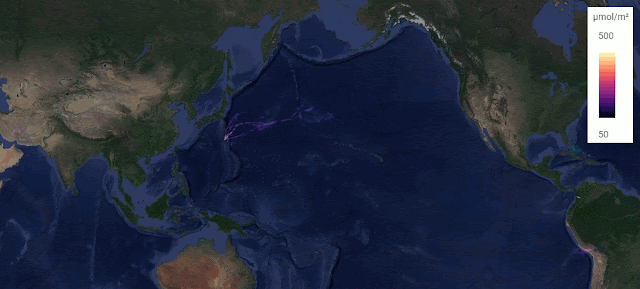- Get link
- X
- Other Apps
In recent weeks the Nishinoshima volcano has been sending plumes of sulfur dioxide (SO2) almost halfway across the Pacific Ocean.
Nishinoshima is a relatively new and active volcanic island located over 900 km off the coast of Japan. On June 15 the Japanese Coast Guard shared images of it erupting, and on June 25 confirmed that it was erupting at a high level of explosivity.
Volcanic gases contain lots of sulfur. Highly explosive eruptions have the potential to inject these gases directly into the stratosphere. This is exactly what is happening with Nishinoshima right now, and it can be seen from space courtesy of the TROPOMI instrument aboard the European Space Agency's Sentinel-5P satellite.
The image below shows the mean concentration of SO2 detected at 15 km above sea level over the past week. During this period Nishinoshima represents the largest single stratospheric SO2 input globally. Multiple distinct plumes of SO2 are visible, with the largest extending thousands of kilometres to the northeast across the Pacific Ocean. In the animation we can see how these plumes have increased in intensity over the month.
 |
| Mean SO2 levels in the troposphere (15 km) from 20 - 26 June, 2020. Sentinel-5P/TROPOMI data processed in Google Earth Engine. |
In the air we breathe SO2 is a major health concern. Released from the burning of coal and other fuels, it reacts with water to make sulfuric acid (H2SO4), leading to hazardous sulfate aerosol particles and acid rain. Natural sulfate aerosols in the higher reaches of the atmosphere are of less concern, although they do interfere with the protective ozone layer.
Another consequence of sulfate aerosols is that they tend to reflect incoming sunlight, causing global dimming. This was seen clearly in the wake of the massive Mt Pinatubo eruption in 1991, which caused a measurable drop in global temperatures over the following years. This has led atmospheric chemists to consider injecting sulfate and other particles into the stratosphere, in a last ditch effort to mitigate the effects of global warming.
But however SO2 makes its way into the atmosphere, we're indebted to the European Space Agency for letting us see it.
 |
| Daily mean SO2 at 15 km from 06 - 26 June, 2020. Sentinel-5P/TROPOMI data processed in Google Earth Engine. |
- Get link
- X
- Other Apps
Comments
Post a Comment